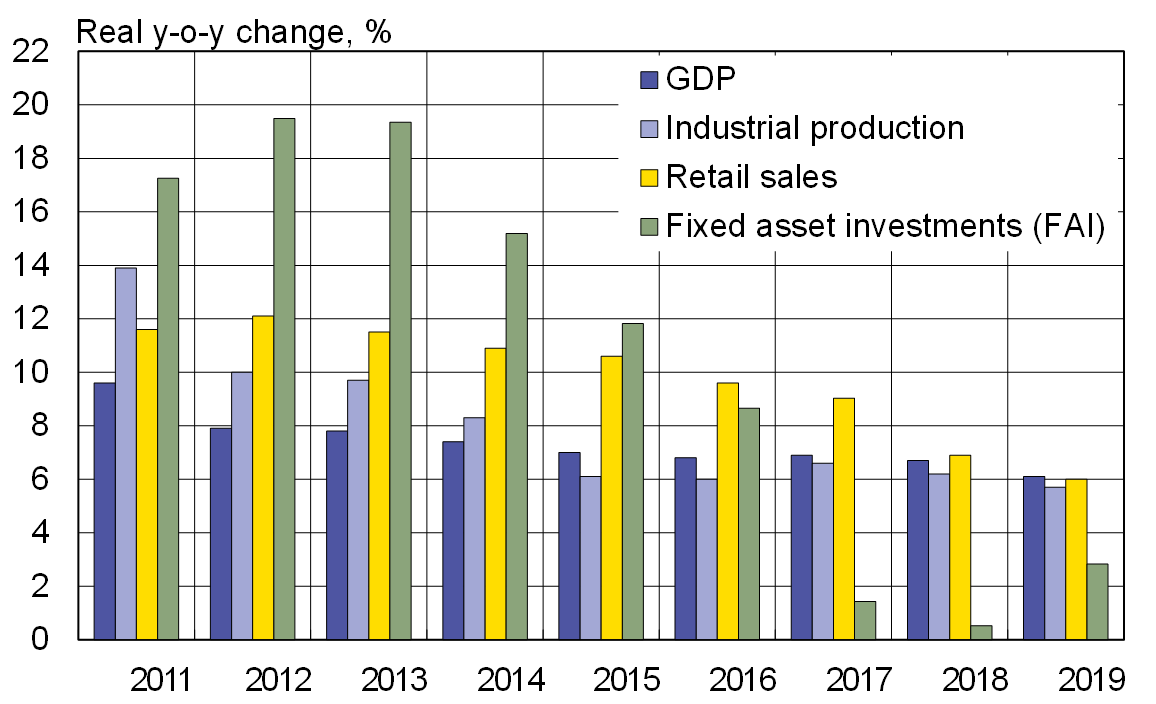BOFIT Weekly Review 04/2020
As expected, China hit its economic growth target last year, but slowdown continues
Newly released figures from China’s National Bureau of Statistics (NBS) show that Chinese GDP grew by 6.1 % last year, putting growth well within the government’s official 2019 target range of 6–6.5 %. On-year growth in the third and fourth quarters of 2019 was just 6 %.
The NBS also revised upwards by o.1 percentage point its annual GDP growth estimates for the 2014 to 2018 period. The growth estimate for 2018 is now 6.7 %. Nominal GDP had already been updated at the end of last year on the basis of the newest census data (BOFIT Weekly 49/2019). The revised figures help lock in the government’s politically important goal of doubling real 2010 GDP by the end of 2020. Reaching that decade-long goal still needs growth of at least 5.6 % this year. Pressure on government officials to meet the GDP growth target is one of several factors that have made Chinese GDP growth figures less than trustworthy, particularly in recent years.
Other economic indicators released by the NBS show an across-the-board slowdown in growth. Industrial output growth was just 5.7 % for all of 2019. Industrial output, however, picked up in December to a pace of 6.9 % y-o-y, likely reflecting a brief year-end recovery.
Growth in retail sales and fixed investment failed also to match the pace of GDP growth. In recent years, domestic consumption has supported China’s economic growth as retail sales growth outstripped GDP growth. Last year, however, real growth in retail sales was just 6 %. Real growth in fixed asset investment (FAI) was only around 3 % last year. Public-sector investment rose faster than private-sector investment.
Household income and spending slightly lagged GDP growth last year. Real per capita disposable incomes increased by 5.8 % y-0-y, while consumer spending was up by 5.5 %. In 2018, disposable incomes increased by 6.5 % (spending up 6.2%). In urban areas, income growth last year was 5 % and median income per capita was 39,240 yuan (5,070 euros). In rural areas, the median income was 14,390 yuan (1,860 euros).
Surveys suggest the urban unemployment rate at the end of December was 5.2 %, up from 4.9 % in December 2018. Chinese unemployment figures show remarkably tiny variation from 5 %, and few observers believe they reflect actual labour market conditions. Even with slowing economic growth, there has, however, been little mention in the news of extensive lay-offs. On the other hand, protests over belated salaries are quite common.
The rise in consumer prices in December matched the November pace of 4.5 % y-o-y. Inflation was pushed up by soaring pork prices, which alone contributed 2.3 percentage points to consumer price inflation. Producer price deflation eased in December, with producer prices declining by just 0.5 % y-o-y (down 1.4 % in November). Consumer prices were up 2.9 % for all of 2019, just below the government’s 3 % target ceiling.
Real on-year growth in GDP, industrial output, retail sales and fixed asset investment

Sources: CEIC and NBS. BOFIT estimates when official figures are otherwise unavailable.